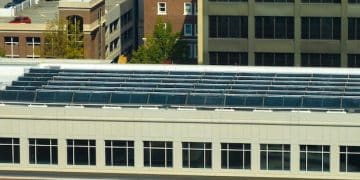Finance Your Energy Storage: US Loans, Leases & Incentives

Financing an energy storage system in the US can be achieved through various options, including loans, leases, and federal, state, and local incentives, each offering different benefits and suitability based on individual circumstances and financial goals.
Investing in energy storage is a smart move for sustainability and energy independence. However, the upfront cost can be a barrier. This article explores how to finance your energy storage system in the US: loans, leases, and incentives, providing a comprehensive guide to make your energy storage goals a reality.
Understanding Energy Storage Systems and Their Benefits
Energy storage systems are increasingly vital components of a modern energy infrastructure. They store energy produced from various sources, including renewables like solar and wind, for later use. This capability offers numerous benefits, making it a worthwhile investment for homeowners and businesses alike.
In this section, we’ll delve into the core advantages of implementing energy storage systems. This includes not only financial and environmental benefits but also increased grid stability and energy independence.
Cost Savings and Energy Independence
One of the primary drivers for adopting energy storage is the potential for significant cost savings. By storing energy during off-peak hours, when prices are lower, and using it during peak demand, consumers can reduce their electricity bills substantially.
Beyond savings, energy storage promotes energy independence. It allows users to rely less on the grid, especially during outages or emergencies, ensuring a continuous power supply.
- Reduce electricity bills by using stored energy during peak hours.
- Minimize reliance on the grid, increasing energy autonomy.
- Protect against power outages and grid instability.

Environmental Benefits
Energy storage plays a critical role in supporting renewable energy adoption. It helps to stabilize the grid by managing the intermittent nature of renewable sources like solar and wind. This ensures a more reliable and sustainable energy supply.
By storing and utilizing renewable energy, users can reduce their carbon footprint, contributing to a cleaner and healthier environment. Energy storage reduces the need for fossil fuel-based power plants.
Ultimately, energy storage systems are a key component in the transition to a more sustainable and resilient energy future. By understanding their benefits, individuals and businesses can make informed decisions about investing in these technologies.
Loans for Energy Storage Systems
Loans represent a straightforward method for financing energy storage systems. They offer the advantage of ownership and flexibility in managing the energy storage asset. However, it’s essential to understand the different types of loans available and their respective terms and conditions.
In this section, we will cover various types of loans tailored for energy storage systems, including personal loans, home equity loans, and specialized energy efficiency loans. We’ll also provide insights on how to secure the best loan terms and interest rates.
Personal Loans
Personal loans are unsecured loans that can be used for various purposes, including financing energy storage systems. These loans typically do not require collateral, making them accessible to a wider range of borrowers.
However, personal loans often come with higher interest rates compared to secured loans. It is crucial to compare offers from multiple lenders to secure the most favorable terms.
Home Equity Loans
Home equity loans leverage the equity you have built in your home. These are secured loans, meaning the lender can foreclose on your property if you fail to repay the loan.
- Typically offer lower interest rates than personal loans.
- Require a home appraisal to determine the loan amount.
- May involve closing costs and fees.
Specialized Energy Efficiency Loans
These loans are specifically designed to finance energy-efficient upgrades, including energy storage systems. Banks and credit unions often offer these loans with competitive interest rates and flexible terms.
Government-backed programs may also provide energy efficiency loans with favorable conditions. These often come with additional incentives or rebates.
Choosing the right loan depends on your financial situation and creditworthiness. Carefully evaluate the terms, interest rates, and fees to make an informed decision and secure the best financing option for your energy storage system.
Leasing Energy Storage Systems
Leasing offers an alternative approach to acquiring energy storage systems without the burden of ownership. This financing method can be attractive for those who prefer lower upfront costs and simplified maintenance.
In this section, we’ll explore the advantages and disadvantages of leasing, along with the types of lease agreements available and what to consider before signing a lease.

Advantages of Leasing
One of the primary benefits of leasing is the reduced upfront cost. You avoid the large capital outlay associated with purchasing an energy storage system.
Leasing often includes maintenance and monitoring services. This simplifies the ownership experience, as the leasing company handles repairs and performance tracking.
- Lower upfront costs and predictable monthly payments.
- Maintenance and monitoring services included.
- Access to the latest technology without long-term commitment.
Disadvantages of Leasing
Over the long term, leasing can be more expensive than purchasing, as you are essentially paying for the use of the system without gaining ownership.
Lease agreements may come with restrictions on modifying or upgrading the system. This can limit your flexibility and control over your energy storage setup.
Types of Lease Agreements
Operating Leases: Short-term leases in which the leasing company retains ownership of the equipment.
Capital Leases: Long-term leases that transfer ownership of the equipment to the lessee at the end of the lease term.
Before entering into a lease agreement, carefully review the terms and conditions. Understand the duration of the lease, monthly payments, maintenance responsibilities, and any potential penalties for early termination. Consider the long-term cost and benefits compared to purchasing the system.
Federal Incentives for Energy Storage
The federal government offers various incentives to promote the adoption of energy storage systems. These incentives can significantly reduce the overall cost and make energy storage more accessible.
In this section, we’ll explore federal tax credits, grants, and other programs designed to encourage investment in energy storage technologies. We’ll also discuss how to navigate the application process and maximize the benefits.
Federal Tax Credits
The Investment Tax Credit (ITC) is a key federal incentive for energy storage. It provides a tax credit for a percentage of the cost of installing an energy storage system.
The ITC can substantially reduce the upfront cost, making energy storage more affordable for homeowners and businesses. Eligibility requirements and credit amounts may vary based on the specific technology and installation date.
Grants and Loan Programs
The Department of Energy (DOE) and other federal agencies offer grants and loan programs to support energy storage projects. These programs often target innovative technologies and large-scale deployments.
Grants can provide direct funding for energy storage projects, while loan programs offer favorable financing terms. Eligibility criteria and funding levels vary depending on the program.
To leverage federal incentives, thoroughly research available programs and their requirements. Gather all necessary documentation and submit your application in a timely manner. Consider consulting with a tax professional or energy consultant to ensure you maximize the benefits.
State and Local Incentives
In addition to federal initiatives, many state and local governments offer their own incentives to encourage energy storage adoption. These incentives can vary widely depending on the location and specific policy goals.
This section will explore various state and local incentives, including rebates, tax credits, and grant programs. We’ll also provide resources to help you find incentives available in your area.
Rebates and Tax Credits
Several states offer rebates for installing energy storage systems. These rebates can provide upfront discounts or reimbursements for a portion of the system cost.
State tax credits offer similar benefits to federal tax credits, reducing your state tax liability. The amount and eligibility criteria vary by state.
- New York: Offers tax credits for energy storage systems.
- California: Provides rebates through the Self-Generation Incentive Program (SGIP).
- Massachusetts: Supports energy storage projects through the Community Storage Initiative.
Grant Programs
States and local governments may offer grant programs to support energy storage projects. These grants can fund feasibility studies, pilot projects, and other initiatives.
Local utility companies may also offer incentives to promote energy storage adoption. These programs are often designed to improve grid resilience and manage peak demand.
To find state and local incentives, start by checking your state’s energy office or public utility commission website. Contact your local government and utility company for information on available programs. Many online resources and databases provide comprehensive listings of energy incentives.
Making the Right Financing Decision
Choosing the right financing option for your energy storage system involves careful consideration of your financial situation, energy needs, and long-term goals. It’s essential to evaluate the pros and cons of different financing methods and select the one that best aligns with your objectives.
In this section, we’ll provide a step-by-step guide to help you make an informed decision, including assessing your financial capacity, comparing different financing options, and seeking professional advice.
Assess Your Financial Capacity
Before exploring financing options, assess your financial situation. Determine how much you can afford to spend on an energy storage system and consider your credit score, income, and debt levels.
Calculate your energy consumption and potential savings. This will help you estimate the return on investment (ROI) for your energy storage system.
Compare Financing Options
Evaluate the different financing options discussed in this article, including loans, leases, and incentives. Compare interest rates, terms, fees, and other costs associated with each option.
Consider the long-term implications of each option. Leasing may provide lower upfront costs, while purchasing offers ownership and potential long-term savings.
Consult with a financial advisor or energy consultant. They can provide personalized advice based on your unique circumstances and help you navigate the complexities of energy storage financing. Take advantage of available incentives to reduce the overall cost of your energy storage system and make it more financially viable. With careful planning, you can choose the perfect financing method to power your energy storage goals.
| Key Aspect | Brief Description |
|---|---|
| 💰 Loans | Finance with ownership; options include personal, home equity, and specialized energy loans. |
| 📝 Leases | Lower upfront costs; includes maintence. Options are operating leases and capital leases. |
| 💡 Federal Incentives | Tax credits, grants, and loan program initiatives for energy storage tech. |
| 📍 State/Local Incentives | Rebates, tax credits and grants to reduce the initial costs. |
Frequently Asked Questions (FAQ)
▼
An energy storage system stores energy for later use, improving grid stability by managing renewable energy intermittency and reducing reliance on fossil fuels.
▼
Loans provide ownership and flexibility, with options like personal, home equity, and energy efficiency loans. However, rates may fluctuate, impacting overall costs.
▼
Leasing has lower upfront costs and maintenance benefits but can be more expensive long-term. There will be restrictions with system modifications limiting flexibility.
▼
The ITC is a primary incentive, offering tax credits. The DOE provides grants and loan programs for innovative projects and large energy storage deployments.
▼
Begin at respective state energy officals or utility websites; local utility companies or local governments can help identify grant programs.
Conclusion
Financing an energy storage system in the US involves exploring loans, leases, and incentives. Each option offers distinct advantages, so carefully consider your circumstances, research available resources, and seek professional advice to make an informed decision and unlock the benefits of energy storage for your home or business.





